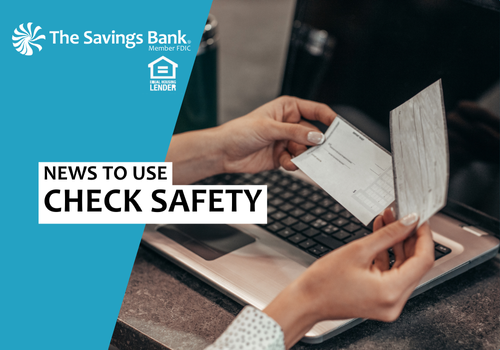Check Safety
08/20/2025

Check Safety
The American Bankers Association (ABA) has a special message about checks! Check fraud has nearly doubled since 2021, despite check use going down 25%. In an effort to thwart check fraud, the ABA has created a campaign to educate consumers on how check fraud works and how to prevent it. Here is a summary of the campaign.
Step 1
Take a look at your checks and all the information that one tiny piece of paper contains. Most checks include your name and some form of contact like address or phone number. Your checks also include account numbers and routing numbers that identify which bank you use. Memo lines provide personal details. And, finally, your signature is right there for anyone to see and possibly copy.
In short, checks are a gold mine of information for scammers. If they gain access to a check you have filled out (or even an empty one), it can lead to fraud, identity theft, and your information being sold on the black market.
Step 2
Let’s learn how check fraud works. Criminals frequently raid mailboxes and intercept mail in search of checks. Once in possession of your check, criminals can “wash” them. This means they erase the filled-out details, such as the payee and amount in order to steal funds for themselves. If check washing doesn’t work out, they can also forge checks using the routing and account numbers they found on your intercepted checks. Using modern printers and software it is easy for them to create believable forgeries.
Step 3
There are steps you can take to decrease the possibility of check fraud. First, you should try to limit check use overall. If you can pay via your bank’s digital payment options, opt for those over paper checks.
Realistically, you will probably still have instances where a paper check is your only option. If so, there are a few ways to make sure your checks are safe. Using permanent gel pens over pencil or normal ink pens will make it difficult for criminals to wash the checks. Avoid leaving blank spaces on your check to make it difficult for scammers to make alterations.
Next, make sure all the space on payee line is used, or swipe a line through the remainder of the space. Use all space available in the amount box so that no one can add digits to the end. And lastly, avoid putting too much personally identifying information on your checks. Do not put information like your social security number, driver’s license number, or phone number.
With this information you are ready to safely send checks! Remember to regularly review your accounts to identify any possible fraud on checks you send. Ensure the amount debited from your account matches the check and the endorsement reflects the intended payee.
Sources:
https://practicesafechecks.com/wp-content/uploads/sites/2/2024/09/PracticeSafeChecksOverview.pdf
https://practicesafechecks.com/safe-check-tips/

